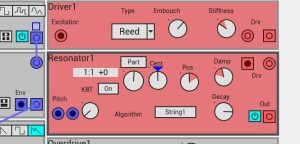This is about some software developement I did for the Nord modular G2 synthesizer. I am not working on this project anymore, but I will keep this website up for a while.
The Nord G2 is a virtual modular synthesizer, this means that it’s basically a computer. On the anolog modular synthesizers you make “patches” by connecting sound processing modules by cables, on the G2, this is done by editing software on a host computer. It communicates with the G2 using a USB connection. One of the nice things about the G2 is that you don’t need the host computer all of the time, you can store patches on the machine and use it on it’s own.
What I am trying to do here is to create an alternative editor for the Nord G2. I am using the software creation tool Delphi for this. These are a couple of things I enjoy doing: creating sounds with the Nord G2 and developing software with Delphi.
There are many interesting aspects for software developers in this G2 editor software: the USB interface, the graphical user interface, multi platform developement and so on. So for me it’s a very good project to learn something new and get some experience on these subjects.
Hidden driver & resonator modules
While I was developing this editor, I found hidden in the firmware a couple of modules that have never been included, for some reason or another, in the original Clavia editor.
These modules are a “driver” and a “resonator”, normally used in physical modeling applications. Here is a picture.
I can’t really tell much about how to use these modules, I guess it’s a matter of experimenting yourself, but you certainly can add some new dimensions to your patches with these modules.
The driver and resonator are located on the oscillator page.
You can use these modules in the editor that I’ve made, but remember that you can’t use these patches with the original editor.
Other functionality
Some other things I’ve added are a VST for use in a DAW that connects to an editor using TCP-IP, also the ability to make connections between editors using TCP-IP. Another thing I’m working on is a version of the editor for small screen Android tablet devices.
Current status of developement
Unfortunately I don’t seem to find time anymore two work on the project. But I took some effort to clean up the projects source code and put it up at github. You can find it at BVerhue/nord_g2_editor.
There are three projects there, first the original windows only editor, then the FMX version, which can also be compiled for OsX. And there is a third which I started for Android, it works but was not finished.
So feel free to do with the source what you wish, fork it, clone it or port it to another language.


This is great!
If we can get this running on debian linux, a raspberry pi with a wifi-adapter mounted inside the g2 chassis acting as both a router and the host for the editor, we can just connect to it’s wifi network and open the editor with any smartphone or tablet.
I would love to help you get this moving. Please, shoot me an email.
Wow! I am reviving my G2 modulars and was looking for the best way to move forward with them.
This looks wonderful!!!
I have a wish list / question list / and if possible to do, would be happy to “hire” your time to do them…
Or if you know someone who is best to make it happen… Thank You!
#1) Could it be possible to control multiple G2 devices from one editor ( I believe the first generation could control “four” units from the editor according to Sound on Sound… I think I had it going on my (3) first gen nord’s years ago too).
#2) A big one for me… Could a module be made to do phase reverse / and time-adjust samples delays (one at a time like Avid/Digidesign’s “Time adjuster” plug-in. Which has a smaller version to go from 1-256 and bigger for longer times)? My ears tell me: when I have an oscillator, and have patched parallel module chains, (different modules patched to different number of modules running parallel chains into mixers), that there are “out of phase” issues and “sample delay” issues causing phase problems and eating bottom or top-end, etc. This could be a simple way to help keep everything fat, warm and big with giant patches. it would be helpful to have a chart of the sample delays of each module too.
Thank you again! R Lawrence
Hi, One other point I’d love …
#3) To be able to receive poly aftertouch from another controller or sequencer (Logic etc.) ! 🙂
Thanks!
RL
Just stumbled upon this and as a longtime Senior Delphi Developer I am absolutely fascinated !
has anyone recompiled this for 64-bit MacOS?